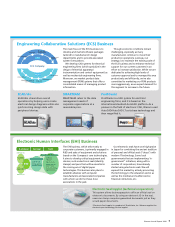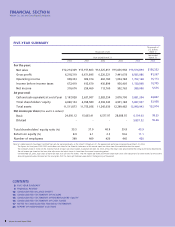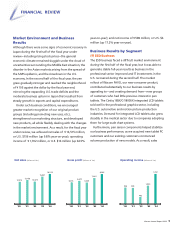Wacom 2004 Annual Report Download - page 19
Download and view the complete annual report
Please find page 19 of the 2004 Wacom annual report below. You can navigate through the pages in the report by either clicking on the pages listed below, or by using the keyword search tool below to find specific information within the annual report.
Wacom Annual Report 2004 17
NOTES TO CONSOLIDATED FINANCIAL STATEMENTS
Wacom Co., Ltd. and Consolidated Subsidiaries
1. Basis of presenting consolidated financial statements:
The accompanying consolidated financial statements have been prepared from
the consolidated financial statements of Wacom Co., Ltd. (the “Company”)
filed with the Director of the Kanto Local Finance Bureau in accordance with
the Securities and Exchange Law of Japan and its related accounting
regulations, and in conformity with accounting principles and practices
generally accepted in Japan, which are different in certain respects from the
application and disclosure requirements of International Financial Reporting
Standards. In addition, the consolidated statements of shareholders’ equity,
which are not required as part of the basic financial statements in Japan, are
presented herein for additional information.
In preparing these consolidated financial statements, certain reclassifications
and rearrangements have been made to the consolidated financial statements
issued domestically in order to present them in a form more familiar to readers
outside Japan. Some information, provided in the notes to the consolidated
financial statements, is not required under accounting principles generally
accepted in Japan, but is also presented for the convenience of the readers.
The consolidated financial statements are not intended to present the
consolidated financial position, results of operations and cash flows in
accordance with accounting principles and practices generally accepted in
countries and jurisdictions other than Japan.
The consolidated financial statements are stated in Japanese yen, the
currency of the country in which the Company is incorporated and principally
operates. The translation of Japanese yen amounts into U.S. dollar amounts is
included solely for the convenience of readers outside Japan and has been
calculated at the rate of ¥105.64 = U.S.$1, the approximate rate of exchange
on March 31, 2004. Such translations should not be construed as
representations that the Japanese yen amounts could have been or could be
converted into U.S. dollars at that or any other rate.
2. Summary of significant accounting policies:
(1) Consolidation
The consolidated financial statements include the accounts of the Company
and all of its majority-owned subsidiaries.
Investments in all affiliated companies, where shareholdings are more than
20% and where the Company has significant influence over their operations,
finance and management, are accounted for by the equity method.
The assets and liabilities of consolidated subsidiaries are incorporated into
the financial statements at fair value, and the difference between the net
assets at fair value and the investment amounts is accounted for as goodwill,
which is amortized equally over 5 years.
All significant intercompany balances and transactions, and unrealized
profit, included in assets, have been eliminated on consolidation.
Overseas-consolidated subsidiaries have adopted accounting principles
generally accepted in their respective countries and no adjustments have been
made to their financial statements on consolidation, as allowed under
accounting principles and practices generally accepted in Japan.
(2) Cash and cash equivalents
Cash and cash equivalents include all highly liquid investments, generally with
original maturities of three months or less that are readily convertible to
known amounts of cash and thus are near maturity so that they present
insignificant risk of changes in value.
(3) Securities
Securities held by the Company and its consolidated subsidiaries are classified
into four categories:
Trading securities are stated at fair value, with changes in fair value included
in net profit or loss for the period in which they arise.
Held-to-maturity debt securities are stated at cost after accounting for any
premium or discount on acquisition, which is amortized over the period to
maturity.
Investments of the Company in equity securities issued by affiliates are
accounted for by the equity method.
Other securities for which market price or quotations are available are stated
at fair value. Net unrealized gains and losses on these securities are reported
as a separate component in shareholders’ equity at a net-of-tax amount.
Other securities for which market quotations are unavailable are stated at cost.
(4) Allowance for doubtful accounts
This allowance for doubtful accounts is provided for estimated future losses
based on past experience, and the allowance is based on an evaluation of the
collectability of individual receivables.
(5) Inventories
Inventories are stated at cost, which is determined by the average method for
the Company.
Inventories are stated at the lower of cost or market value, which is
determined by the FIFO method for foreign subsidiaries.
(6) Property, plant and equipment and depreciation
Property, plant and equipment are stated at costs. Depreciation, except for
buildings, is computed by the declining-balance method at rates based on the
estimated useful lives of the assets. Depreciation of buildings at overseas
subsidiaries and those acquired by the Company on or after April 1, 1998 is
computed primarily by the straight-line method.
Major useful lives are as follows:
Buildings and facilities 3 to 65 years
Machinery, equipment and vehicles 5 to 13 years
Tools and furniture 2 to 20 years
Ordinary maintenance and repair costs are charged to income as incurred.
Major replacements and improvements are capitalized.
(7) Software
Software for internal use is amortized by the straight-line method over an
estimated useful life (5 years). Software to be sold is amortized based on the
estimated volume of sales with the minimum amortization amount calculated
based on the useful life of 3 years.
(8) Accrued retirement benefits
Lump-sum severance indemnity regulations of the Company, which cover
substantially all employees, provide for benefit payments determined by
reference to the employee’s current basic rate of pay, length of service,
position in the Company and termination circumstances.
The accrued retirement benefits represent the actuarially calculated present
value of projected benefit obligation in excess of the fair value of the plan
assets except for, as permited under the standard, the unrecognized transition
obligation and the unrecognized actuarial differences. The unrecognized
transition obligation is being amortized on a straight-line basis over 5 years,
and the unrecognized actuarial differences are being amortized on a straight-
line basis over 5 years from the next year in which they arise.
With respect to directors and statutory corporate auditors, provision is made
for lump-sum severance indemnities based on internal regulations.
(9) Income taxes
Deferred income taxes are recognized, using the asset and liability method.
This method is used to recognize deferred tax assets and liabilities for the
expected future tax consequences of temporary differences between the
carrying amounts of assets and liabilities for financial reporting purposes and
the amounts used for income tax purposes.
(10) Leases
Leases that transfer substantially all the risks and rewards of ownership of the
assets are accounted for as capital leases; Leases do not transfer ownership of
the assets at the end of the lease term, are accounted for as operating leases
in accordance with accounting principles and practices generally accepted in
Japan.
(11) Appropriations of retained earnings
Appropriations of retained earnings are reflected in the financial statements in
the year they are approved at the general meeting of shareholders.
(12) Foreign currency translation
Foreign currency transactions are translated using foreign exchange rates
prevailing at the transaction dates.
All monetary assets and liabilities denominated in foreign currencies,
whether they are long-term or short-term, are translated into Japanese yen at
the exchange rates prevailing at the balance sheet date. Resulting gains and
losses are included in the consolidated statement of income.
All assets and liabilities of foreign subsidiaries are translated at current rates
at the respective balance sheet date and all the income and expense accounts
are translated at average rates for respective periods. Foreign currency
translation adjustments are presented as a component of "Shareholders’
equity" in the consolidated financial statements.
(13) Recently issued new accounting standards
On August 9, 2002, the Business Accounting Council in Japan has issued
"Accounting Standard for Impairment of Fixed Assets". The standard requires
that fixed assets be reviewed for impairment whenever events or changes in
circumstances indicate that the carrying amount of an asset may not be
recoverable. An impairment loss shall be recognized in the income statement
by reducing the carrying amount of impaired assets or a group of assets to the
recoverable amount which is measured at the higher of net selling price or
value in use.
The standard shall be effective for fiscal years beginning April 1, 2005.
However, an earlier adoption is permitted for fiscal years beginning April 1,
2004 and for fiscal years ending after March 31, 2004.
This standard has not been applied in the consolidated financial statements,
and the Company is currently in the process of assessing the potential impact
that this standard will have on the Company’s financial position.
(14) Reclassifications
Certain reclassifications of the financial statements and related footnote
amounts in the year ended March 31, 2003 have been made to conform to
the presentation in the year ended March 31, 2004.























